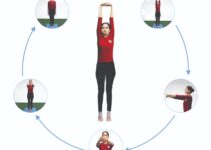What is Garudasana?
Garudasana (gah-rue-DAHS-anna) is comprised of garuda = ‘a fierce bird of prey’ and asana means ‘yoga pose’. Garuda is the bird that transports Lord Vishnu throughout the celestial realms. It is also the vehicle (vahana) of the Hindu god Vishnu, usually described as an eagle but sometimes as a hawk or kite. This asana is ‘the eagle pose’ because it resembles a garuda or an eagle. It is an essential standing yoga pose that stretches the shoulders, upper back, and legs; known for other important health benefits. Its easy steps to use and precautions have been mentioned systematically. The yoga pose develops poise and grace in the body. The yoga pose is also known for strength, flexibility, and endurance.

How to do Garudasana step by step?
The simple technique and instructions of the eagle are:
- Stand in Tadasana with hands beside the thighs.
- Raise the right leg and twist it around the left leg.
- Now fold the two arms at the elbows.
- Twist the left arm around the right arm. Try to place the palms together so that they resemble the beak of an eagle or garuda.
- Gaze at a fixed point in front of the body. Slowly bend the leg and lower the body as far as you can.
- Keep your eyes fixed on the point in front of the body.
- Now, repeat the same procedure with the other leg and arm.
Breathing and awareness
Breathing should be regular throughout the entire practice. One’s attention should be fixed on a point before the body. The best place is a black spot on the wall at the level of eyes. Awareness of a selected issue is the secret of balancing asanas. As far as duration is concerned, one can stay at the final pose as per one’s comfort.
Top 10 health benefits of Garudasana
To extract the best benefits of Garudasana, one must practice the eagle pose according to the instructions above. Maximum benefits can be harnessed if you practice it in the presence of a yoga teacher or after having perfection. Some of the essential benefits of this yoga pose are:
- Mental & physical coordination: The yoga pose helps to bring coordination between body and mind, thus suitable to bring synergy in the body, thereby helpful in combating stress and depression.
- Strengthens the legs: It’s an effective yoga pose for the legs muscles, tones the nerves and loosens the joints. It strengthens the feet and thighs too. Thus, the practice of it lengthening the legs and also helpful in overcoming the leg’s deformity.
- Hydrocele: Few yoga poses work for patients with hydrocele. Garudasana is essential in treating hydrocele problems if correctly practised for a certain period.
- Alleviates sciatica: Regular yoga pose practice helps treat sciatica. It is also beneficial in the case of rheumatism.
- Testicle development: The yoga pose is beneficial in case of enlargement of the testicles.
- Urinary problems: It has been helpful for patients with anorectal and urinary disorders.
- Concentration: The yoga pose helps to develop concentration.
- Balance: It is also known to develop balance in the body.
- Good for shoulders: The yoga pose is good for shoulders, upper back, and arms. Those seated continuously before the computer must practice this yoga pose to lessen the stiffness in the arms and shoulders.
- Neuro-muscular health: It is good to enhance neuromuscular coordination.
Precautions
The eagle pose shouldn’t be performed in the following conditions
- Severe arthritis
- Varicose veins
- Injuries of bones and joints.
- 3rd-trimester pregnancy shouldn’t practice it.
- It should also be avoided in case of low blood pressure, headache, and inner ear problems.
- Alignment, especially of hands, arms, and thighs, is important in the case of Garudasana.
- While performing it, the back should be straight as the rounded back seems less beneficial.
- Avoid practising it if you have knee, elbow, arms, and shoulder injuries.
Joint and muscular actions
While practising the yoga pose, joint and muscular actions are involved. Mild spinal flexion; scapula abduction, upward and lateral rotation, elevation; glenohumeral external rotation; elbow flexion; forearm pronation; neutral wrist extension; pelvis anterior tilt, counternutation; hip flexion, internal rotation, adduction; knee flexion, internal rotation; ankle dorsiflexion; foot—lifted in eversion and standing in slight supination.
Beginner’s tip
Initially, practising yoga pose takes more work. The fresher should practice it with the help of a wall. There are problems with balance and stability in the case of beginners.
Philosophy and origin
The name comes from the Sanskrit words garuda, which means ‘eagle’ and asana, which means ‘yoga posture’. In Hindu mythology, it is the vehicle of God Vishnu to save humanity from cruel demons. In Gheranda Samhita, verse 2.37, wherein it has been described as the legs and thighs on the ground and the hands on the knees. It has also been described in Sritattvanidhi and by BKS Iyengar in Light on Yoga.
Preparatory pose
- Tadasana
- Utkatasana
- Vrikshasana
- Gomukhasana
Counter pose
- Trikonasana
- Setu bandha sarvangasana
- Natrajasna
- Utkatkonasana





